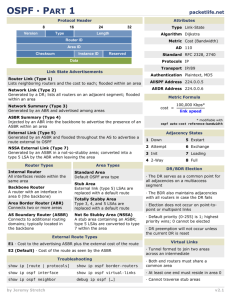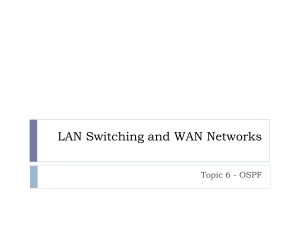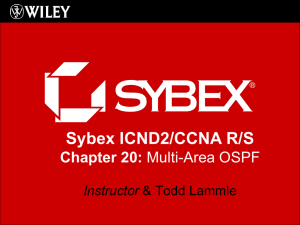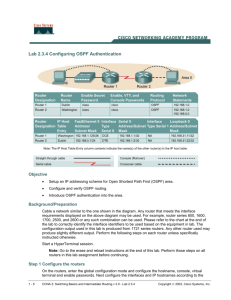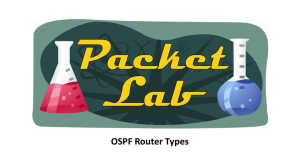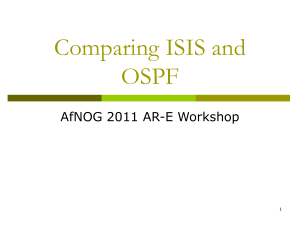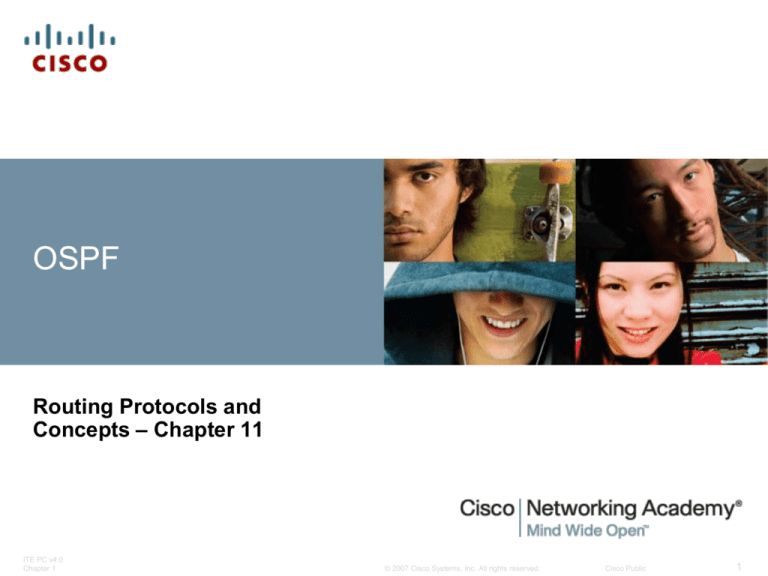
OSPF
Routing Protocols and
Concepts – Chapter 11
ITE PC v4.0
Chapter 1
© 2007 Cisco Systems, Inc. All rights reserved.
Cisco Public
1
11.0.1 Chapter Introduction
Describe the background and basic features of OSPF
Identify and apply the basic OSPF configuration
commands
Describe, modify and calculate the metric used by
OSPF
Describe the Designated Router/Backup Designated
Router (DR/BDR) election process in multiaccess
networks
Describe the uses of additional configuration
commands in OSPF
11.0.1 Chapter Introduction
11.1.1 Background of OSPF
The initial development of OSPF began in 1987 by the Internet
Engineering Task Force (IETF) OSPF Working Group. At that time the
Internet was largely an academic and research network funded by the
U.S. government.
11.1.2 OSPF Message Encapsulation
OSPF Message Encapsulation
OSPF packet type
There exist 5 types
OSPF packet header
Contains - Router ID and area ID and Type code for OSPF packet type
IP packet header
Contains - Source IP address, Destination IP address, & Protocol field
set to 89
Data link frame header
Contains - Source MAC address and Destination MAC address
11.1.2 OSPF Message Encapsulation
11.1.3 OSPF Packet Types
Five Packet Types
11.1.4 Hello Protocol
OSPF Hello Packet
–Purpose of Hello Packet
• Discover OSPF neighbors & establish adjacencies
• Advertise guidelines on which routers must agree to become
neighbors
• Used by multi-access networks to elect a designated router
and a backup designated router
11.1.4 Hello Protocol
OSPF Hello Intervals
–Usually multicast (224.0.0.5 reserved) sent every 10 seconds
–Sent every 30 seconds for NBMA segments (Frame Relay – X25 – ATM)
OSPF Dead Intervals
–This is the time that must transpire before the neighbor is considered down
–Default time is 4 times the hello interval
Both routers must
agree to form
adjacencies
11.1.4 Hello Protocol
Hello protocol packets contain information that is used in
electing:
-Designated Router (DR)
DR is responsible for updating all other OSPF routers
-Backup Designated Router (BDR)
This router takes over DR’s responsibilities if DR fails
No DR/BDR designations occur on point-to-point links
11.1.5 Link State Updates
Purpose of a Link State Update (LSU)
Used to deliver link state advertisements
Purpose of a Link State Advertisement (LSA)
Contains information about neighbors & path costs
N
O
T
E
Hello packets are used to:
• Discover OSPF neighbors and establish
neighbor adjacencies.
• Advertise parameters on which two
routers must agree to become
neighbors.
• Elect the Designated Router (DR) and
Backup Designated Router (BDR) on
multiaccess networks like Ethernet and
Frame Relay.
11.1.6 OSPF Algorithm
OSPF routers build & maintain link-state database containing LSA received
from other routers
Information found in database is utilized upon execution of Dijkstra SPF
algorithm
SPF algorithm used to create SPF tree
SPF tree used to populate routing table
11.1.7 Administrative Distances
Administrative distance (AD) is the trustworthiness (or preference) of the route
source. OSPF has a default administrative distance of 110. As you can see from
the figure, when compared to other interior gateway protocols (IGPs), OSPF is
preferred over IS-IS and RIP.
Default Administrative Distances
11.1.8 Authentication
OSPF Authentication
• Purpose is to encrypt & authenticate routing information
• This is an interface specific configuration
• Routers will only accept routing information from other routers that
have been configured with the same password or authentication
information
11.2.1 Lab Topology
Topology used for this chapter
Discontiguous IP addressing scheme
Since OSPF is a classless routing protocol the subnet mask is
configured in OSPF configuration
Default serial link
speed 1544 kps
Can be changed
11.2.2 Router OSPF Command
The router ospf command
To enable OSPF on a router use the following command
R1(config)#router ospf process-id
Process id
A locally significant number between 1 and 65535
-this means it does not have to match other OSPF
routers
11.2.3 The Network Command
OSPF network command
Requires entering: network address wildcard mask - the inverse of the
subnet mask
area-id - area-id refers to the OSPF area.
OSPF area is a group of routers that share link state information
-Example: Router(config-router)#network network-address
wildcard-ask area area-id
11.2.4 OSPF Router ID
Router ID
This is an IP address used to identify a router
3 criteria for deriving the router ID
1. Use IP address configured with OSPF router-id command
Takes precedence over loopback and physical interface addresses
2. If router-id command not used then router chooses highest IP
address of any loopback interfaces
3. If no loopback interfaces are configured then the highest IP address
on any active interface is used
11.2.4 OSPF Router ID
Because we have not configured router IDs or loopback interfaces on our three
routers, the router ID for each router is determined by the highest active IP
address on any of the router's physical interfaces. As shown in the figure, the
router ID for each router is:
R1: 192.168.10.5, which is higher than either 172.16.1.17 or 192.168.10.1
R2: 192.168.10.9, which is higher than either 10.10.10.1 or 192.168.10.2
R3: 192.168.10.10, which is higher than either 172.16.1.33 or 192.168.10.6
11.2.4 OSPF Router ID
Commands used to verify current router ID
Show ip protocols
Show ip ospf
Show ip ospf interface
11.2.4 OSPF Router ID
OSPF Router ID
Router ID & Loopback addresses
-Highest loopback address will be used as router ID if router-id
command isn’t used
-Advantage of using loopback address
the loopback interface cannot fail OSPF stability
The OSPF router-id command
–Introduced in IOS 12.0
–Command syntax
Router(config)#router ospfprocess-id
Router(config-router)#router-idip-address
Modifying the Router ID
–Use the command Router#clear ip ospf process
11.2.4 OSPF Router ID
In this topology, all three routers have been configured with loopback
addresses to represent the OSPF router IDs. The advantage of using a
loopback interface is that - unlike physical interfaces - it cannot fail. There
are no actual cables or adjacent devices on which the loopback interface
depends for being in the up state. Therefore, using a loopback address for
the router ID provides stability to the OSPF process. Because the OSPF
router-id command, which is discussed next, is a fairly recent addition to
IOS, it is more common to find loopback addresses used for configuring
OSPF router IDs.
11.2.4 OSPF Router ID
If the OSPF router-id command is not used and loopback interfaces are
configured, OSPF will choose highest IP address of any of its loopback
interfaces. A loopback address is a virtual interface and is automatically in
the up state when configured. You already know the commands to
configure a loopback interface:
Router(config)#interface loopback number
Router(config-if)#ip address ip-address subnet-mask
11.2.5 Verifying OSPF
Verifying OSPF
Use the show ip ospf command to verify & trouble shoot OSPF
networks
Command will display the following:
Neighbor adjacency
-No adjacency indicated by Neighboring router’s Router ID is not displayed
A state of full is not displayed
-Consequence of no adjacencyNo link state information exchanged
Inaccurate SPF trees & routing tables
11.2.5 Verifying OSPF
Command
Show ip protocols
Show ip ospf
Show ip ospf interface
Description
Displays OSPF process ID,
router ID, networks router is
advertising & administrative
distance
Displays OSPF process ID,
router ID, OSPF area information
& the last time SPF algorithm
calculated
Displays hello interval and dead
interval
11.2.6 Examining the Routing Table
Examining the routing table
Use the show ip route command to display the routing table
-An “O’ at the beginning of a route indicates that the router
source is OSPF
-Note OSPF does not automatically summarize at major
network boundaries
11.2.6 Examining the Routing Table
Use the Packet Tracer Activity to
configure and verify basic OSPF
routing.
11.3.1 OSPF Metric
OSPF uses cost as the metric for determining the best route
-The best route will have the lowest cost
-Cost is based on bandwidth of an interface
Cost is calculated using the formula
108 / bandwidth
-Reference bandwidth
defaults to 100Mbps
can be modified using
auto-cost reference-bandwidth command
11.3.1 OSPF Metric
COST of an OSPF route
Is the accumulated value from one router to the next
11.3.1 OSPF Metric
Usually the actual speed of a link is different than the default bandwidth
–This makes it imperative that the bandwidth value reflects link’s
actual speed
Reason: so routing table has best path information
The show interface command will display interface’s bandwidth
-Most serial link default to 1.544Mbps
11.3.2 Modifying the Cost of a Link
Modifying the Cost of a link
• Both sides of a serial link should be configured with the same
bandwidth
– Commands used to modify bandwidth value
Bandwidth command
– Example: Router(config-if)#bandwidthbandwidth-kbps
ip ospf cost command – allows you to directly specify
interface cost
– -Example:R1(config)#interface serial 0/0/0
–
R1(config-if)#ip ospf cost 1562
11.3.2 Modifying the Cost of a Link
An alternative method to using the bandwidth command is to use the ip ospf
cost command, which allows you to directly specify the cost of an interface.
For example, on R1 we could configure Serial 0/0/0 with the following command:
R1(config)#interface serial 0/0/0
R1(config-if)#ip ospf cost 1562
11.3.2 Modifying the Cost of a Link
• Difference between bandwidth command & the ip ospf cost command
– Ip ospf cost command
Sets cost to a specific value
– Bandwidth command
Link cost is calculated
Use the Packet Tracer Activity to
modify the cost values for OSPF.
11.4.1 Challenges in Multi-access Networks
A point-to-point network
there are only two devices
on the network, one at
each end. The WAN link
between R1 and R3 is an
example of a point-to-point
link.
A multiaccess network is a network with more than two devices on the
same shared media. In the top portion of the figure, the Ethernet LAN
attached to R1 is extended to show possible devices that might be
attached to the 172.16.1.16/28 network. Ethernet LANs are an example of
a broadcast multiaccess network. They are broadcast networks because
all devices on the network see all broadcast frames. They are multiaccess
networks because there may be numerous hosts, printers, routers, and
other devices that are all members of the same network.
11.4.1 Challenges in Multi-access Networks
• OSPF defines five network types:
–
–
–
–
–
Point-to-point
Broadcast Multiaccess
Nonbroadcast Multiaccess (NBMA)
Point-to-multipoint
Virtual links
11.4.1 Challenges in Multi-access Networks
• 2 challenges presented by multiaccess networks
– Multiple adjacencies
– Extensive LSA flooding
11.4.1 Challenges in Multi-access Networks
• Extensive flooding of LSAs
– For every LSA sent out there must be an acknowledgement of
receipt sent back to transmitting router.
– consequence: lots of bandwidth consumed and chaotic traffic
11.4.1 Challenges in Multi-access Networks
• Solution to LSA flooding
issue is the use of
– Designated router (DR)
– Backup designated
router (BDR)
• DR & BDR selection
– Routers are elected to
send & receive LSA
• Sending & Receiving LSA
– DRothers send LSAs via
multicast 224.0.0.6 to
DR & BDR
– DR forward LSA via
multicast address
224.0.0.5 to all other
routers
11.4.2 DR/BDR Election Process
DR/BDR Election Process
• DR/BDR elections DO NOT occur in point to point networks
11.4.2 DR/BDR Election Process
DR/BDR elections will take place on multiaccess networks as shown
below
11.4.2 DR/BDR Election Process
•
Criteria for getting elected DR/BDR
1. DR: Router with the highest OSPF interface priority.
– 2. BDR: Router with the second highest OSPF interface priority.
– 3. If OSPF interface priorities are equal, the
–
highest router ID is used to break the tie.
11.4.2 DR/BDR Election Process
11.4.2 DR/BDR Election Process
• Timing of DR/BDR Election
– Occurs as soon as 1st router has its interface enabled on multiaccess
network
When a DR is elected it remains as the DR until one of the
following occurs
– -The DR fails.
– -The OSPF process on the DR fails.
– -The multiaccess interface on the DR fails.
• Manipulating the election process
– -If you want to influence the election of DR & BDR then do
one of the following
Boot up the DR first, followed by the BDR, and then boot
all other routers, OR
Shut down the interface on all routers, followed by a no
shutdown on the DR, then the BDR, and then all other
routers.
11.4.3 OSPF Interface Priority
OSPF Interface Priority
• Manipulating the DR/BDR election process continued
– Use the ip ospf priority interface command.
– Example:Router(config-if)#ip ospf priority {0 - 255}
Priority number range 0 to 255
– 0 means the router cannot become the DR or BDR
– 1 is the default priority value
11.4.3 OSPF Interface Priority
Use this Packet Tracer Activity to
examine current DR and BDR roles,
watch the roles change, and then force
new roles by changing priority.
11.5.1 Redistributing a Default OSPF Route
Let's return to the earlier topology, which now includes a new link to ISP. As with RIP
and EIGRP, the router connected to the Internet is used to propagate a default route
to other routers in the OSPF routing domain. This router is sometimes called the
edge, entrance or gateway router. However, in OSPF terminology, the router located
between an OSPF routing domain and a non-OSPF network is called the
Autonomous System Boundary Router (ASBR). In this topology, the Loopback1
(Lo1) represents a link to a non-OSPF network. We will not configure the
172.30.1.1/30 network as part of the OSPF routing process
11.5.1 Redistributing the OSPF Default Route
• Topology includes a link to ISP
– Router connected to ISP
Called an autonomous system border router
Used to propagate a default route
– Example of static default route
– R1(config)#ip route 0.0.0.0 0.0.0.0 loopback 1
– Requires the use of the default-information originate
command
– Example of default-information originate command
– R1(config-router)#default-information originate
OSPF requires the
use of the defaultinformation
originate command
to advertise the
0.0.0.0/0 static
default route to the
other routers in the
area.
11.5.2 Fine Tuning OSPF
Reference Bandwidth
As you remember, Cisco OSPF cost uses accumulated bandwidth. The bandwidth
value of each interface is calculated using 100,000,000/bandwidth. 100,000,000 or
10 to the 8th is known as the reference bandwidth.
Therefore, 100,000,000 is the default bandwidth referenced when the actual
bandwidth is converted into a cost metric.
In order to obtain more accurate cost calculations, it may be necessary to adjust the
reference bandwidth value. The reference bandwidth can be modified to
accommodate these faster links by using the OSPF command auto-cost
reference-bandwidth. When this command is necessary, use it on all routers so
that the OSPF routing metric remains consistent.
R1(config-router)#auto-cost reference-bandwidth ?
1-4294967 The reference bandwidth in terms of Mbits per second
11.5.2 Fine Tuning OSPF
Since link speeds are getting faster it may be necessary to change
reference bandwidth values
–Do this using the auto-cost reference-bandwidth command
–Example:
R1(config-router)#auto-cost reference-bandwidth 10000
11.5.2 Fine Tuning OSPF
Modifying OSPF Intervals
The show ip ospf neighbor command on R1 verifies that R1 is adjacent to R2 and
R3. Notice in the output that the Dead Time is counting down from 40 seconds. By
default, this value is refreshed every 10 seconds when R1 receives a Hello from the
neighbor.
It may be desirable to change the OSPF timers so that routers will detect network
failures in less time. Doing this will increase traffic, but sometimes there is a need
for quick convergence that outweighs the extra traffic.
OSPF Hello and Dead intervals can be modified manually using the following
interface commands:
Router(config-if)#ip ospf hello-interval seconds
Router(config-if)#ip ospf dead-interval seconds
11.5.2 Fine Tuning OSPF
Modifying OSPF timers
–Reason to modify timers
Faster detection of network failures
–Manually modifying Hello & Dead intervals
Router(config-if)#ip ospf hello-interval seconds
Router(config-if)#ip ospf dead-interval seconds
–Point to be made
Hello & Dead intervals must be the same between neighbors
11.5.2 Fine Tuning OSPF
Use the Packet Tracer Activity to
configure a default route and
propagate it within the OSPF routing
process. Also, practice changing the
reference bandwidth as well as the
Hello and Dead intervals.
11.6.1 Basic OSPF Configuration Lab
In this lab activity, there are two separate scenarios. In the first scenario,
you will learn how to configure the routing protocol OSPF using the
network shown in the Topology Diagram in Scenario A. The segments of
the network have been subnetted using VLSM. OSPF is a classless
routing protocol that can be used to provide subnet mask information in the
routing updates. This will allow VLSM subnet information to be propagated
throughout the network.
In the second scenario, you will learn to configure OSPF on a multi-access
network. You will also learn to use the OSPF election process to determine
the designated router (DR), backup designated router (BDR), and DRother
states.
11.6.1 Basic OSPF Configuration Lab
Use this Packet Tracer Activity to
repeat a simulation of Lab 11.6.1.
Remember, however, that Packet
Tracer is not a substitute for a handson lab experience with real equipment.
A summary of the instructions is
provided within the activity. Use the
Lab PDF for more details.
11.6.2 Challenge OSPF Configuration Lab
In this lab activity, you will be given a network
address that must be subnetted using VLSM to
complete the addressing of the network shown in
the Topology Diagram. A combination OSPF
routing and static routing will be required so that
hosts on networks that are not directly connected
will be able to communicate with each other.
OSPF area ID of 0 and process ID of 1 will be
used in all OSPF configurations.
11.6.2 Challenge OSPF Configuration Lab
Use this Packet Tracer Activity to repeat a
simulation of Lab 11.6.2. Remember,
however, that Packet Tracer is not a
substitute for a hands-on lab experience
with real equipment.
A summary of the instructions is provided
within the activity. Use the Lab PDF for
more details.
11.6.3 OSPF Troubleshooting Lab
In this lab, you will begin by loading configuration scripts on each of
the routers. These scripts contain errors that will prevent end-to-end
communication across the network.
You will need to troubleshoot each router to determine the
configuration errors, and then use the appropriate commands to
correct the configurations.
When you have corrected all of the configuration errors, all of the
hosts on the network should be able to communicate with each
other.
11.6.3 Troubleshooting an OSPF Configuration Lab
Use this Packet Tracer Activity to repeat a
simulation of Lab 11.6.3. Remember,
however, that Packet Tracer is not a
substitute for a hands-on lab experience
with real equipment.
A summary of the instructions is provided
within the activity. Use the Lab PDF for
more details.
11.7.1 Summary and Review
RFC 2328 describes OSPF link state concepts and
operations
OSPF Characteristics
–A commonly deployed link state routing protocol
–Employs DRs & BDRs on multi-access networks
DRs & BDRs are elected
DR & BDRs are used to transmit and receive LSAs
–Uses 5 packet types:
1: HELLO
2: DATABASE DESCRIPTION
3: LINK STATE REQUEST
4: LINK STATE UPDATE
5: LINK STATE ACKNOWLEDGEMENT
11.7.1 Summary and Review
OSPF Characteristics
–Metric = cost
Lowest cost = best path
Configuration
–Enable OSPF on a router using the following command
R1(config)#router ospf process-id
–use the network command to define which interfaces will
participate in a given OSPF process
Router(config-router)#network network-address
wildcard-mask area area-id
11.7.1 Summary and Review
Verifying OSPF configuration
–Use the following commands
show ip protocol
show ip route
show ip ospf interface
show ip ospf neighbor
11.7.1 Summary and Review
11.7.1 Summary and Review
The Packet Tracer Skills Integration Challenge Activity integrates all
the knowledge and skills you acquired in previous chapters of this
course and prior courses. Skills related to this chapter's discussion of
OSPF are also included.
In this activity, you build a network from the ground up. Starting with an
addressing space and network requirements, you must implement a
network design that satisfies the specifications. Next, you implement
an effective OSPF routing configuration with integrated default routing.
Detailed instructions are provided within the activity.
ITE PC v4.0
Chapter 1
© 2007 Cisco Systems, Inc. All rights reserved.
Cisco Public
65




